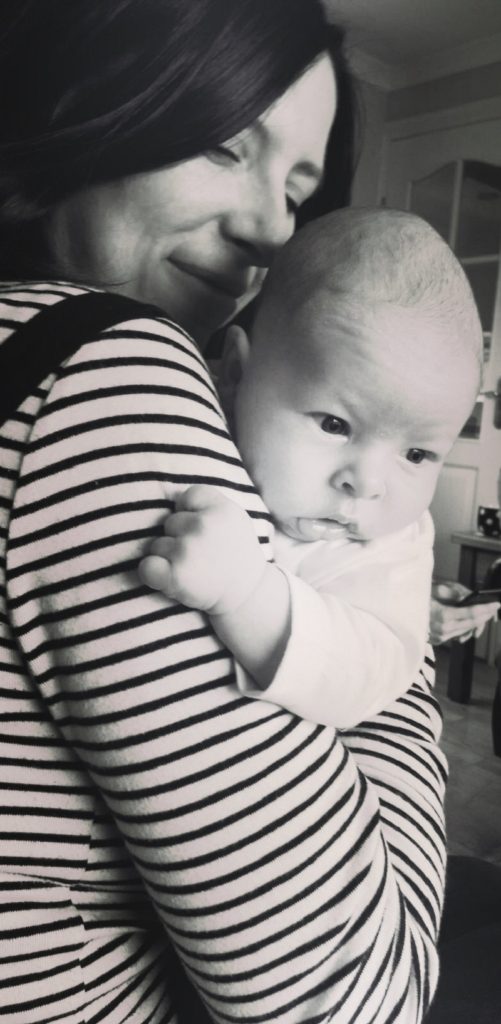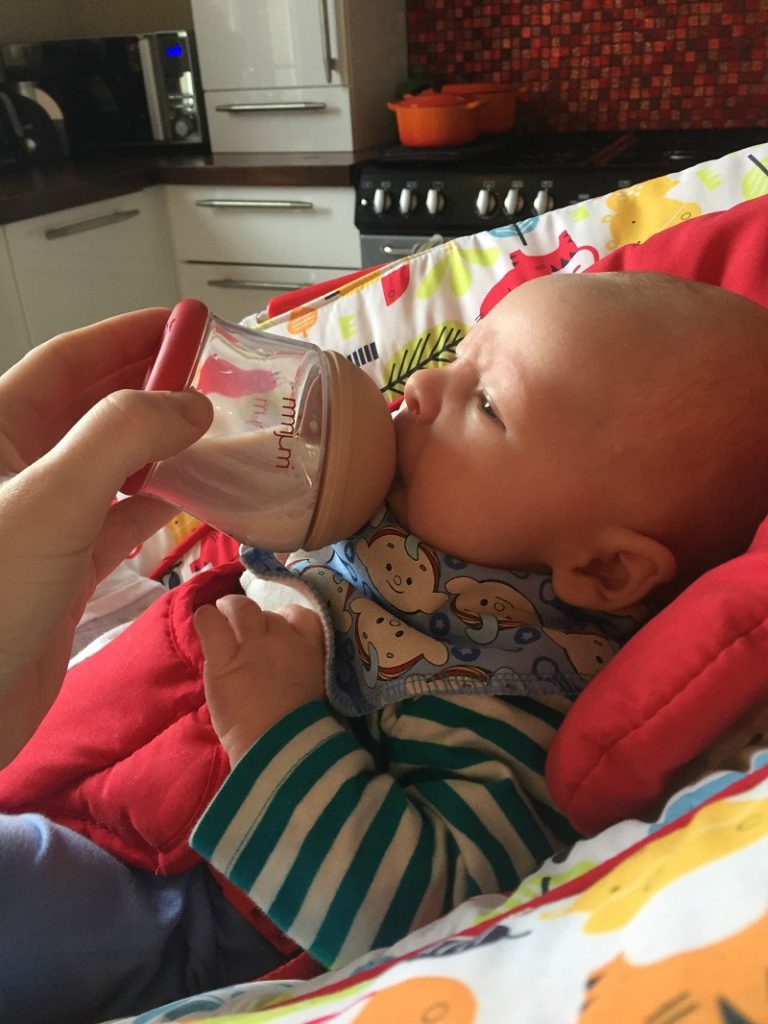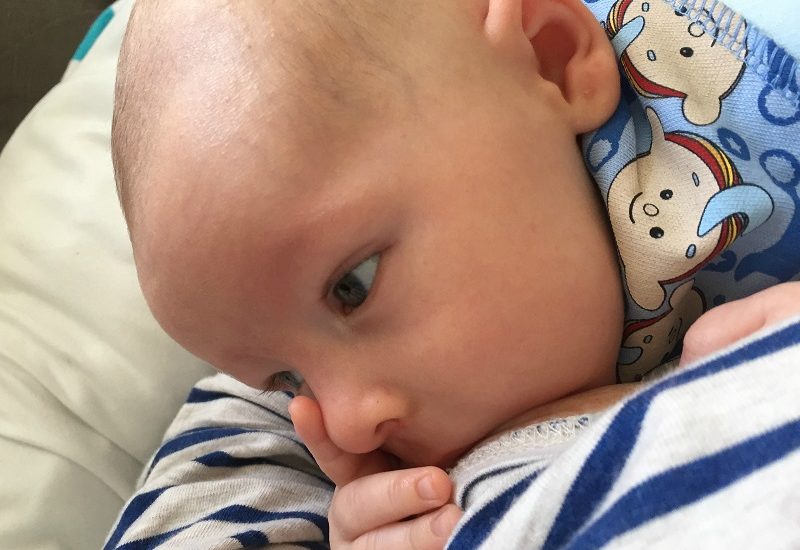For all those claims of how ‘natural’ it is, breastfeeding is HARD. My first child was born in early February and despite the fact I never really planned to breastfeed (read more about that here) I’ve been doing so exclusively for 12 weeks now. Here’s what I’ve learned along the way.
Be Prepared
Before baby arrives, regardless of whether you plan to breast, bottle, or combine feed I recommend that you physically and mentally prepare for all feeding options. Stock up on a few bottles, a steriliser, formula, and read up on breastfeeding. Some might argue this sets you up for failure with breastfeeding but I beg to differ. Having all the feeding options to hand empowered me because I knew I had a Plan B whichever way I decided to feed my son. And anything which keeps you sane in those early weeks is worth investing in.

Tongue Tie
Despite tongue tie being so common and a big barrier to breastfeeding, the NHS does not routinely screen for it. So rather than it going undetected and consequently struggling with breastfeeding, know how to identify tongue tie by googling images. If you do spot it, then you can immediately bring it to the attention of your midwives. It should be fairly easy to take a peek inside your baby’s mouth when they’re exercising their lungs.
Support
Accept all the breastfeeding support you are offered in those early days and don’t be afraid to ask for more. I had an unanticipated 24 hour stay in the hospital for observations and without this, and the support I received during this time, I don’t think I’d have continued breastfeeding past the first 48 hours. In hindsight I wish I’d accepted the additional overnight stay for breastfeeding support when offered.
Baby Weight
Don’t be alarmed if your baby loses some of their birth weight in the first week: this is normal particularly with breastfed babies. The NHS will allow for a 10% loss of birth weight before they recommend a feeding plan. My son was 7lbs 4.5oz when he was born and lost 7% of his birth weight but he regained it easily over the following week and no one expressed any concern.

Demand Feeding
Feeding on demand is recommended by the NHS and this is to help you establish a good milk supply. Essentially, the more the baby feeds the more your body will produce milk thus demand feeding is focused on looking out for feeding cues and feeding baby when they need it. For my son, this meant feeding him 10-12 times in a 24 hour period in those early weeks. I still feed on demand, but at 12 weeks old he now feeds approx. 6-8 times in a 24 hour period.
Demand feeding is HARD and it can be demoralising at times, especially when you’re recovering from the labour. However it does mean you are more likely to have a good milk supply, which consequently means baby is getting all the food he/she needs & is more likely to gain weight. To get through it, I think it helps to just accept that those first few weeks of your baby’s life, your life will comprise of sleep, eat, feed baby (most likely while you’re eating), shower and nothing else. My advice is to spend the first week or 2 on the sofa or in bed recovering while you demand feed and let everyone else run around after you.
Boob Care
I thankfully never suffered from cracked or bleeding nipples although they did get a little tender and dry in that first week. But the trick is to (a) establish a good latch and (b) take care of your nipples from Day 1, especially if you have problems with the latch. Moisturise your breasts daily after you shower (I liked Palmers Bust Cream), apply a thin layer of Lanolin to your nipples regularly throughout the day, and air them after feeding when you can.
Your milk will most likely come in between Days 3-5 during which time your breasts will swell and become very hard. I actually found this more uncomfortable rather than painful. Wear loose tops, a supportive but not restrictive bra (I found sleeping nursing bras the best) and try warm or cold compresses if your breasts are painful. Expressing milk can also help, as will feeding on demand. But as soon as you can, get fitted for a bra but be prepared to get fitted again and potentially end up a different size. A good fitting bra is not only comfortable but can reduce the risk of blocked milk ducts which can lead to mastitis.
IMO, don’t let your baby use your nipples as a dummy. My son is notorious for this after he’s finished feeding and I refuse to let him because it hurts and I know its a one way track to sore nipples. The best way to avoid this is to ask the Midwives for advice on how to tell the difference between sucking and drinking: if its the latter, baby’s jaw muscles under their ears will be moving and you should be able to hear swallowing.

Know the Signs
I’ve never had mastitis (touch wood!) but I have had blocked milk ducts and by god, that was agony so I dread to think what its successor is like. If you feed on demand, from both breasts, and you take care of your boobs then theoretically you shouldn’t end up with blocked milk ducts or mastitis but it does help to recognise the signs of both so you can take immediate action.
In my experience, blocked milk ducts felt like a hard lump in my breast (the kind you’re told to look out for when doing a breast exam). I also felt sluggish, achy, and my breasts felt very hot to the touch. I was advised that in order to get rid of this, to drain this breast immediately (either by pumping or by nursing) by nursing for longer on this breast: which worked. Mastitis on the other hand has the same symptoms but you may also feel fluish, have a fever, and have redness over your breasts. If you spot this, contact your healthcare provider asap. Even if you are worried but aren’t sure, call them.
Pain?
They say breastfeeding isn’t meant to hurt, and if it does then you’re doing it wrong. Nah, that’s BS in my experience. Latching on can be sore even if you have a great latch to begin with. I found latching on sore up until week 4ish and thankfully now I feel nothing. The milk let down however still hurts me to the point I wince in pain sometimes: it’s like sharp pins and needles. However I don’t think the entire feeding session should feel painful, and if it does then it will hardly be an enjoyable experience you’ll want to continue so do seek support if it persists.
You do however need to be aware that breastfeeding can cause the cramping, which occurs after labour, to be more painful. This is simply your uterus shrinking and a little pain is to be expected, but as I was told, it can be more painful due to the breastfeeding hormones. I found the 1st night to be the worst, imagine very VERY strong period cramps, and I was taking ibuprofen and paracetamol at the advice of my Midwives. The upshot is that your stomach is more likely to shrink back faster. I was fully expecting to look pregnant for a long time after I gave birth but by Day 5, my belly was gone (!)
Cluster Feeding
Cluster is the worst IF you’re not prepared for it. I had no idea what cluster feeding was, I guess that’s what comes with reading nothing about breastfeeding before doing it, but I can see how many would confuse baby’s cluster feeding with a lack of milk. Cluster feeding is simply your baby feeding more to tell your breasts to produce more milk for an upcoming growth spurt.
James had quite a few cluster feeding days in the first 6 weeks and I survived it by simply accepting that on those days, I wouldn’t achieve anything. I’d shower, stay in my PJs, park myself on the sofa with supplies, eat food I could manage 1 handed, and catch up on Netflix. Thankfully cluster feeding would only last 1 day tops, sometimes even half a day, so sleep deprivation wasn’t an additional issue.
Which Breast was Last?
Put a bobble around your wrist to remind you which side you last fed on. You might also find it useful to keep track of how long you nurse on each breast at least in those early weeks. The longer baby feeds will at least ensure they’re reaching the rich hind milk which is what helps baby gain weight. Over time you should be able to tell whether the baby has reached the hind milk by monitoring their behaviour: their sucking will slow down and their eyes will start to close.
Be Prepared
In those early weeks, nursing sessions can last for at least 45 mins (and longer if the baby is cluster feeding) so make sure that before you settle down to nurse you have everything you need to hand. For me this included: a water bottle, a snack I could eat 1 handed, my phone, the TV remote or Ipad, a blanket, and a muslin. It’s also worthwhile scheduling a trip to the toilet before you settle down to nurse. As the weeks go on, the nursing sessions will likely become shorter. Nowadays James will feed for approx. 15-20 minutes and I’ve also mastered the art of nursing 1 handed while walking about the house which makes life a LOT easier. I don’t do this often, but it stops me feeling like I’m bound to the sofa.
Breast Pads
Stock up on breast pads for when you need them. For me this wasn’t until Week 3. Now many women don’t need breast pads, power to you if that’s the case, but I can easily soak through my clothes in a matter of hours so the mega absorbent ones are ideal for me. Lanisoh and Tommee Tippee do great breast pads, they’re approx. £3 for a box of 50, and because they are larger they don’t pop out of bra when I’m nursing which I often find is the case with the cheaper Supermarket own-brand ones.

Feeding in Public
Try to feed in public sooner rather than later because the longer you put it off, the bigger a deal it becomes. In my experience, breastfeeding in public wasn’t as bad as I expected. I went out on Day 4 with my aunt and Mum to buy new bras, and I ended up nursing James in a fairly busy M&S Cafe. I think having that support with me, that first time, gave me the confidence to nurse and stopped me getting flustered when he started crying for food. Since then, when I feed in public, no one really notices and when they do it’s mostly women who barely bat an eyelid. To be fair, I am discreet but I don’t go about with a breastfeeding cover (which in my mind draws more attention to it), I find James’ head covers my modesty nicely anyway.
If you are concerned, then perhaps practice in front of a mirror or in front of your family/partner to build your confidence. Over time and with practice you’ll learn neat little ways to be discreet and comfortable in all manner of environments.
Layer the Clothes
Don’t worry about buying pricey nursing clothes, just wear layers. I always wear a nursing bra, a light low cut vest (I like these from H&M) with one of my regular tops. This means I can slip the vest down and pull the top up to nurse, and I’m not baring an expanse of skin in public.
Breast Pumping
I was, and still am, very keen to express and offer the occasional bottle to James for when we’re apart. If I do continue breastfeeding past 6 months I’m also keen to use breast milk in food I prepare for James (i.e. mixing it into purees and mashed foods). I started expressing at Week 6 and I’ve been fortunate to have a good milk supply however I do find expressing and breastfeeding tiring, because it feels like you never get a break, but with a little manoeuvring I can express from 1 side while feeding from the other.
If you’re planning to do the same, then I recommend investing in a pumping bra (which leaves you hands free), a good pump, and plenty of reusable storage pots for your milk. I have the Phillips Avent Single Pump which I love and the customer service from Phillips is fantastic especially when ordering or returning spare parts. Rather than buy the single-use breastmilk storage bags, which I find pricey, I use the Phillips Avent storage pots instead. These were £14 for a pack of 10 on Prime, they can be dishwashed/sterilised and used again and again. I can also pump directly into these pots, and when James is weaned I see myself using them to store and transport his food.

Introducing the Bottle
If you are wanting to introduce a bottle (of formula or breast milk) the recommended advice is to be cautious about when you introduce it: too early and risk nipple confusion, and too late and baby is likely to refuse it. What precisely is the “magic” period in between I have no idea however the NHS do recommend you wait until breastfeeding has been established and this is normally around the 6 week mark.
I waited until James was 6 weeks old before introducing a bottle of breastmilk and he refused it, I’ve since then been facing a battle of wills trying to get him to accept a bottle so that I can have a little me time. In hindsight, I didn’t need to wait the 6 weeks because for us, breastfeeding was already well established (in that James had no problems, I had a good milk supply etc) by about Week 4. I do wonder if I introduced the bottle sooner would he have accepted it. My advice is to listen to your instinct and go with what feels right for you rather than listen solely to the official advice because as we all know, every baby is different.


